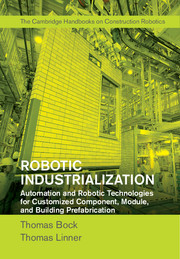 Robotic Industrialization
Robotic Industrialization Published online by Cambridge University Press: 05 August 2015
Japan has the most successful housing prefabrication industry in the world and has maintained this position for about 40 years. Today, the Japanese prefabrication industry manufactures about 150,000 entirely prefabricated housing units per annum with a continuously increasing degree of quality and embedded technologies. During peak times, the percentage of completely prefabricated houses in Japan was about 18 to 19%; the total market share of prefabricated elements is much higher and probably the highest one in the world. Besides the large and consistent market share, it is remarkable that the industry supplies the upper market segments (rather than the lower market segments) with fully customized, earthquake-resistant high-tech buildings.
In Japan, buildings constructed from prefabricated elements are not significantly more expensive than conventionally built buildings and include in most cases proactive building maintenance services bundled to them (i.e., service plans that not only repair damages when they occur but also consistently inspect and maintain the building) to guarantee that the building and its subsystems are consistently functioning and not causing any inconveniences to inhabitants or owners. To be able to provide outstanding quality, almost all manufacturers use automated machines and robot systems in their factories and organize their means of production along a production chain or even production line. The average salaries paid by Japanese prefabrication companies are among the highest in the Japanese general industry. Most Japanese prefabrication companies have no strong roots in the construction industry but rather originate from multinational chemical, electronics, or automotive companies.
Currently, the Japanese LSP industry advances directed towards adding and emphasizing complex additional functions and services playing a major role in the country's disaster prevention and disaster management strategy and developing and delivering entire “smart” cities that are sustainable, affordable, and assistive. Japan's prefabrication industry changes the notion of buildings recognized as simple “construction” products towards the notion of buildings recognized as complex high-tech products with completely new, service-oriented value creation possibilities – and its advanced manufacturing capability is the backbone for this evolution.
To save this book to your Kindle, first ensure [email protected] is added to your Approved Personal Document E-mail List under your Personal Document Settings on the Manage Your Content and Devices page of your Amazon account. Then enter the ‘name’ part of your Kindle email address below. Find out more about saving to your Kindle.
Note you can select to save to either the @free.kindle.com or @kindle.com variations. ‘@free.kindle.com’ emails are free but can only be saved to your device when it is connected to wi-fi. ‘@kindle.com’ emails can be delivered even when you are not connected to wi-fi, but note that service fees apply.
Find out more about the Kindle Personal Document Service.
To save content items to your account, please confirm that you agree to abide by our usage policies. If this is the first time you use this feature, you will be asked to authorise Cambridge Core to connect with your account. Find out more about saving content to Dropbox.
To save content items to your account, please confirm that you agree to abide by our usage policies. If this is the first time you use this feature, you will be asked to authorise Cambridge Core to connect with your account. Find out more about saving content to Google Drive.